Discussion Posts on Therapeutic Communication and Healthcare Topics
VerifiedAdded on 2023/01/23
|7
|1720
|98
Discussion Board Post
AI Summary
This document comprises a series of discussion posts addressing various healthcare topics. The posts delve into therapeutic communication, emphasizing its importance for healthcare professionals and exploring its application in different scenarios, including patient interactions and family support. The discussions also analyze cardiovascular disease, examining its causes and the role of nurses in patient education and nutritional strategies. Furthermore, the posts explore qualitative research, its strengths, limitations, and the use of mixed research designs. Evidence-based practice is another key area, with an emphasis on the collection and appraisal of both qualitative and quantitative evidence. The posts also tackle the nursing workforce shortage in the United States, discussing the challenges and potential solutions, such as implementing magnet hospitals. Finally, the role of nurse practitioners is examined, comparing their responsibilities and contributions to those of primary care physicians. The document provides a comprehensive overview of these crucial healthcare issues, supported by relevant research and literature.
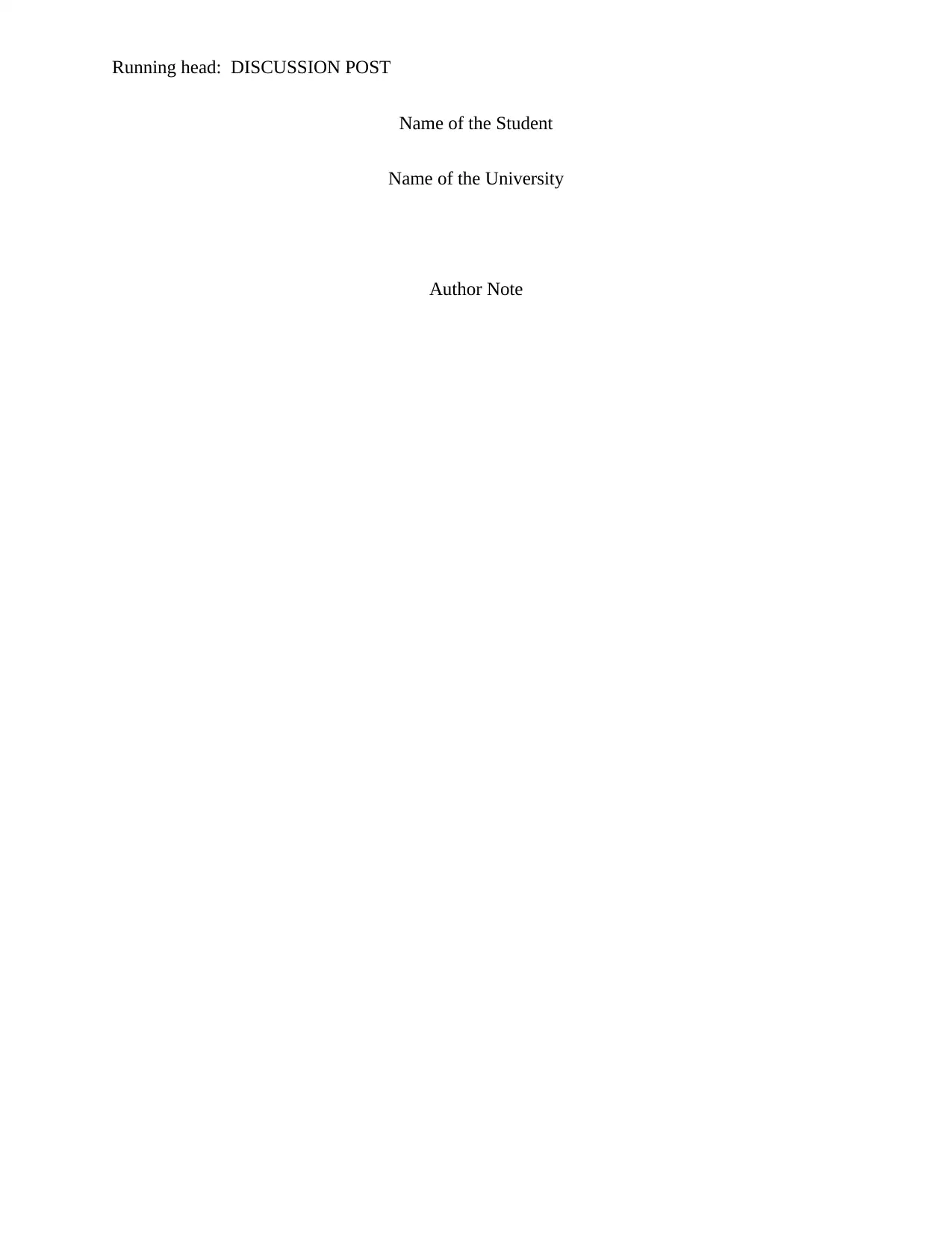
Running head: DISCUSSION POST
Name of the Student
Name of the University
Author Note
Name of the Student
Name of the University
Author Note
Paraphrase This Document
Need a fresh take? Get an instant paraphrase of this document with our AI Paraphraser
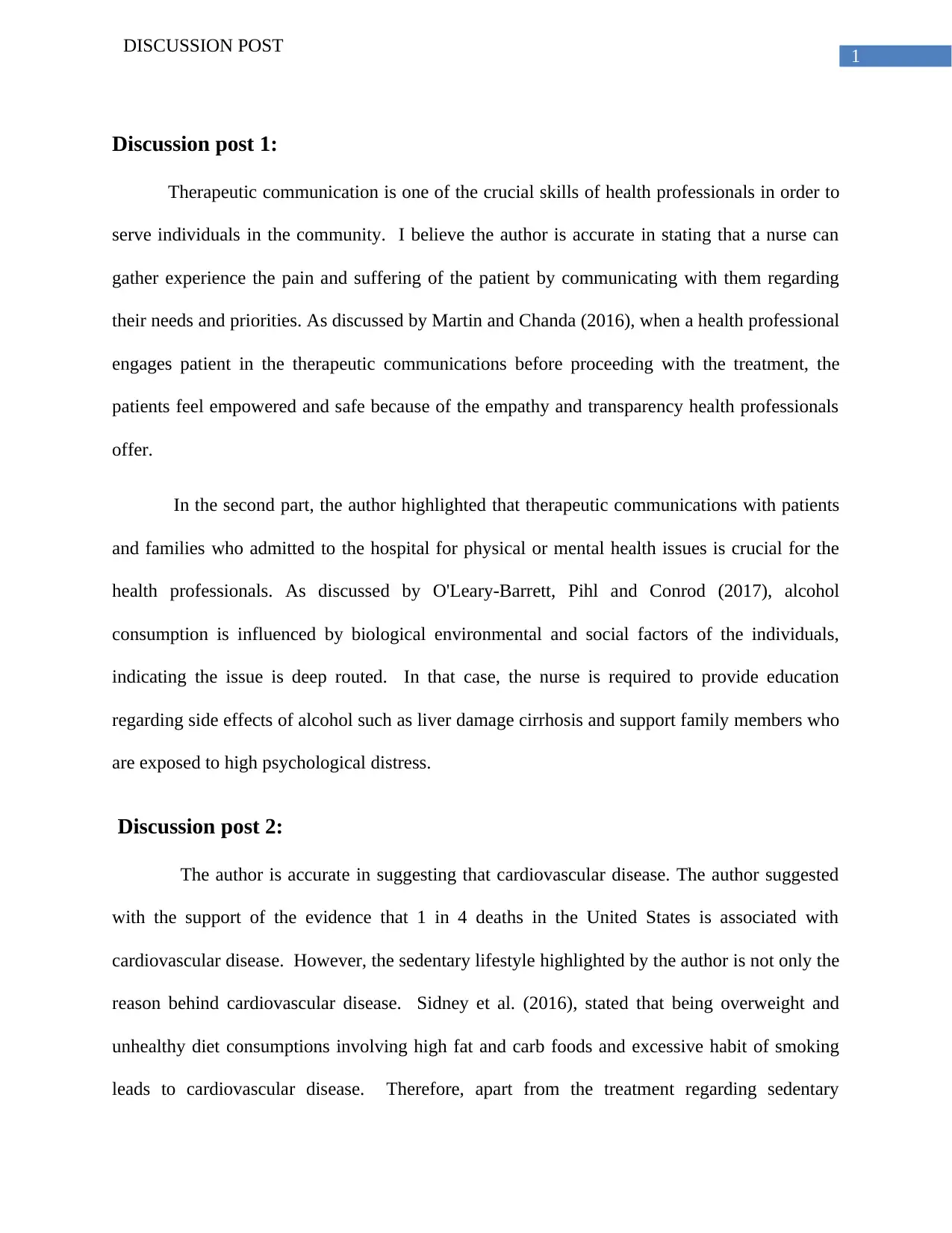
1
DISCUSSION POST
Discussion post 1:
Therapeutic communication is one of the crucial skills of health professionals in order to
serve individuals in the community. I believe the author is accurate in stating that a nurse can
gather experience the pain and suffering of the patient by communicating with them regarding
their needs and priorities. As discussed by Martin and Chanda (2016), when a health professional
engages patient in the therapeutic communications before proceeding with the treatment, the
patients feel empowered and safe because of the empathy and transparency health professionals
offer.
In the second part, the author highlighted that therapeutic communications with patients
and families who admitted to the hospital for physical or mental health issues is crucial for the
health professionals. As discussed by O'Leary-Barrett, Pihl and Conrod (2017), alcohol
consumption is influenced by biological environmental and social factors of the individuals,
indicating the issue is deep routed. In that case, the nurse is required to provide education
regarding side effects of alcohol such as liver damage cirrhosis and support family members who
are exposed to high psychological distress.
Discussion post 2:
The author is accurate in suggesting that cardiovascular disease. The author suggested
with the support of the evidence that 1 in 4 deaths in the United States is associated with
cardiovascular disease. However, the sedentary lifestyle highlighted by the author is not only the
reason behind cardiovascular disease. Sidney et al. (2016), stated that being overweight and
unhealthy diet consumptions involving high fat and carb foods and excessive habit of smoking
leads to cardiovascular disease. Therefore, apart from the treatment regarding sedentary
DISCUSSION POST
Discussion post 1:
Therapeutic communication is one of the crucial skills of health professionals in order to
serve individuals in the community. I believe the author is accurate in stating that a nurse can
gather experience the pain and suffering of the patient by communicating with them regarding
their needs and priorities. As discussed by Martin and Chanda (2016), when a health professional
engages patient in the therapeutic communications before proceeding with the treatment, the
patients feel empowered and safe because of the empathy and transparency health professionals
offer.
In the second part, the author highlighted that therapeutic communications with patients
and families who admitted to the hospital for physical or mental health issues is crucial for the
health professionals. As discussed by O'Leary-Barrett, Pihl and Conrod (2017), alcohol
consumption is influenced by biological environmental and social factors of the individuals,
indicating the issue is deep routed. In that case, the nurse is required to provide education
regarding side effects of alcohol such as liver damage cirrhosis and support family members who
are exposed to high psychological distress.
Discussion post 2:
The author is accurate in suggesting that cardiovascular disease. The author suggested
with the support of the evidence that 1 in 4 deaths in the United States is associated with
cardiovascular disease. However, the sedentary lifestyle highlighted by the author is not only the
reason behind cardiovascular disease. Sidney et al. (2016), stated that being overweight and
unhealthy diet consumptions involving high fat and carb foods and excessive habit of smoking
leads to cardiovascular disease. Therefore, apart from the treatment regarding sedentary
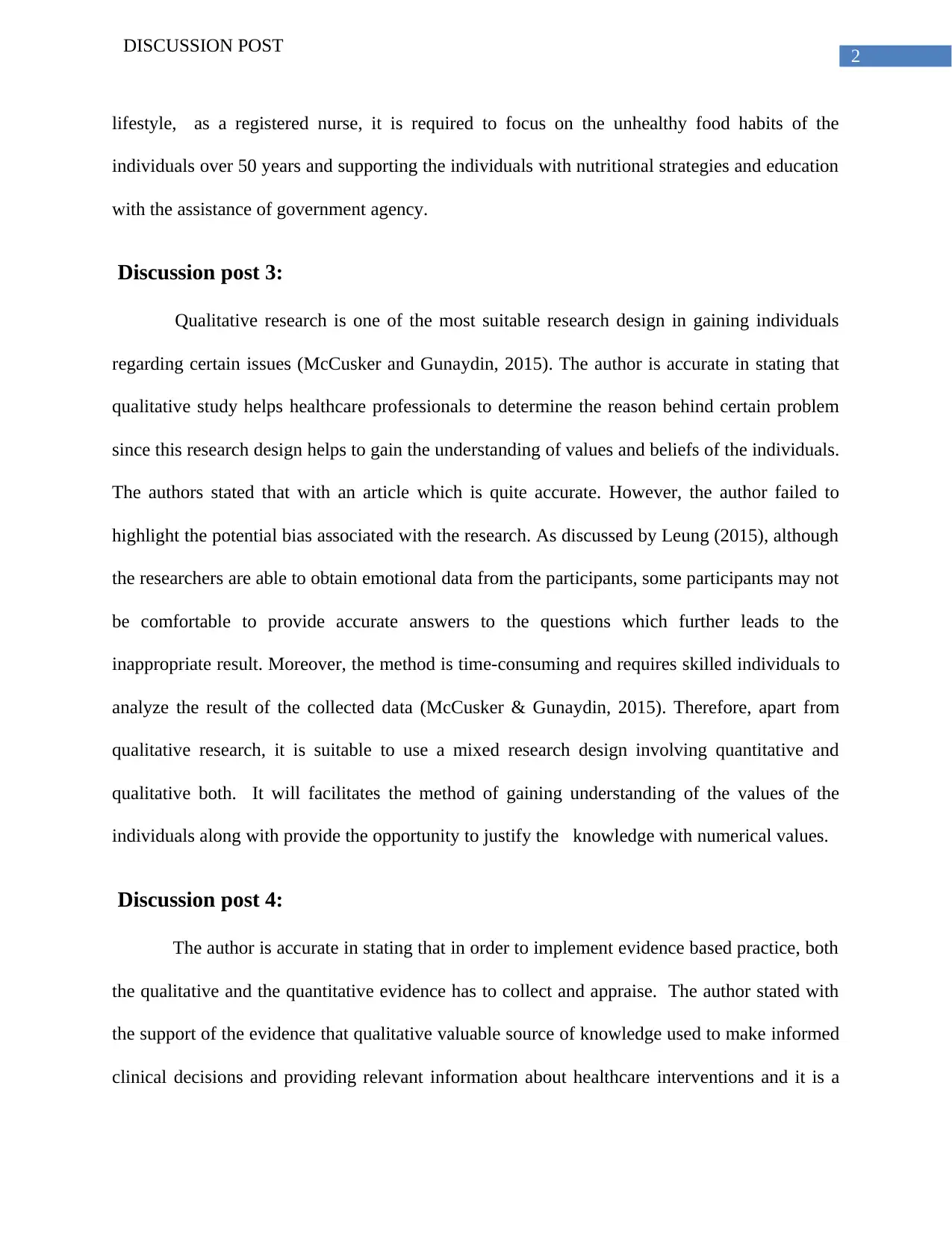
2
DISCUSSION POST
lifestyle, as a registered nurse, it is required to focus on the unhealthy food habits of the
individuals over 50 years and supporting the individuals with nutritional strategies and education
with the assistance of government agency.
Discussion post 3:
Qualitative research is one of the most suitable research design in gaining individuals
regarding certain issues (McCusker and Gunaydin, 2015). The author is accurate in stating that
qualitative study helps healthcare professionals to determine the reason behind certain problem
since this research design helps to gain the understanding of values and beliefs of the individuals.
The authors stated that with an article which is quite accurate. However, the author failed to
highlight the potential bias associated with the research. As discussed by Leung (2015), although
the researchers are able to obtain emotional data from the participants, some participants may not
be comfortable to provide accurate answers to the questions which further leads to the
inappropriate result. Moreover, the method is time-consuming and requires skilled individuals to
analyze the result of the collected data (McCusker & Gunaydin, 2015). Therefore, apart from
qualitative research, it is suitable to use a mixed research design involving quantitative and
qualitative both. It will facilitates the method of gaining understanding of the values of the
individuals along with provide the opportunity to justify the knowledge with numerical values.
Discussion post 4:
The author is accurate in stating that in order to implement evidence based practice, both
the qualitative and the quantitative evidence has to collect and appraise. The author stated with
the support of the evidence that qualitative valuable source of knowledge used to make informed
clinical decisions and providing relevant information about healthcare interventions and it is a
DISCUSSION POST
lifestyle, as a registered nurse, it is required to focus on the unhealthy food habits of the
individuals over 50 years and supporting the individuals with nutritional strategies and education
with the assistance of government agency.
Discussion post 3:
Qualitative research is one of the most suitable research design in gaining individuals
regarding certain issues (McCusker and Gunaydin, 2015). The author is accurate in stating that
qualitative study helps healthcare professionals to determine the reason behind certain problem
since this research design helps to gain the understanding of values and beliefs of the individuals.
The authors stated that with an article which is quite accurate. However, the author failed to
highlight the potential bias associated with the research. As discussed by Leung (2015), although
the researchers are able to obtain emotional data from the participants, some participants may not
be comfortable to provide accurate answers to the questions which further leads to the
inappropriate result. Moreover, the method is time-consuming and requires skilled individuals to
analyze the result of the collected data (McCusker & Gunaydin, 2015). Therefore, apart from
qualitative research, it is suitable to use a mixed research design involving quantitative and
qualitative both. It will facilitates the method of gaining understanding of the values of the
individuals along with provide the opportunity to justify the knowledge with numerical values.
Discussion post 4:
The author is accurate in stating that in order to implement evidence based practice, both
the qualitative and the quantitative evidence has to collect and appraise. The author stated with
the support of the evidence that qualitative valuable source of knowledge used to make informed
clinical decisions and providing relevant information about healthcare interventions and it is a
⊘ This is a preview!⊘
Do you want full access?
Subscribe today to unlock all pages.

Trusted by 1+ million students worldwide
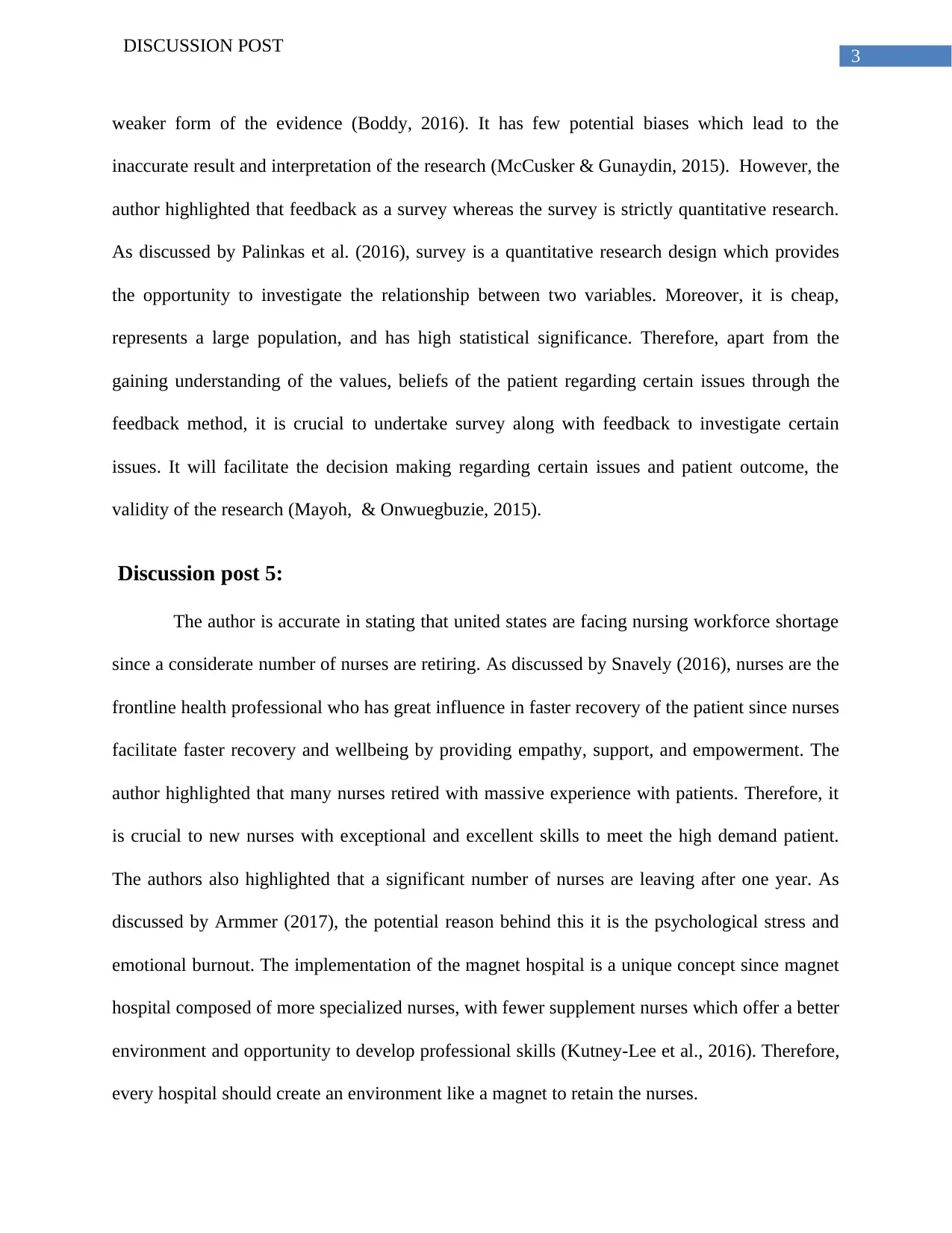
3
DISCUSSION POST
weaker form of the evidence (Boddy, 2016). It has few potential biases which lead to the
inaccurate result and interpretation of the research (McCusker & Gunaydin, 2015). However, the
author highlighted that feedback as a survey whereas the survey is strictly quantitative research.
As discussed by Palinkas et al. (2016), survey is a quantitative research design which provides
the opportunity to investigate the relationship between two variables. Moreover, it is cheap,
represents a large population, and has high statistical significance. Therefore, apart from the
gaining understanding of the values, beliefs of the patient regarding certain issues through the
feedback method, it is crucial to undertake survey along with feedback to investigate certain
issues. It will facilitate the decision making regarding certain issues and patient outcome, the
validity of the research (Mayoh, & Onwuegbuzie, 2015).
Discussion post 5:
The author is accurate in stating that united states are facing nursing workforce shortage
since a considerate number of nurses are retiring. As discussed by Snavely (2016), nurses are the
frontline health professional who has great influence in faster recovery of the patient since nurses
facilitate faster recovery and wellbeing by providing empathy, support, and empowerment. The
author highlighted that many nurses retired with massive experience with patients. Therefore, it
is crucial to new nurses with exceptional and excellent skills to meet the high demand patient.
The authors also highlighted that a significant number of nurses are leaving after one year. As
discussed by Armmer (2017), the potential reason behind this it is the psychological stress and
emotional burnout. The implementation of the magnet hospital is a unique concept since magnet
hospital composed of more specialized nurses, with fewer supplement nurses which offer a better
environment and opportunity to develop professional skills (Kutney-Lee et al., 2016). Therefore,
every hospital should create an environment like a magnet to retain the nurses.
DISCUSSION POST
weaker form of the evidence (Boddy, 2016). It has few potential biases which lead to the
inaccurate result and interpretation of the research (McCusker & Gunaydin, 2015). However, the
author highlighted that feedback as a survey whereas the survey is strictly quantitative research.
As discussed by Palinkas et al. (2016), survey is a quantitative research design which provides
the opportunity to investigate the relationship between two variables. Moreover, it is cheap,
represents a large population, and has high statistical significance. Therefore, apart from the
gaining understanding of the values, beliefs of the patient regarding certain issues through the
feedback method, it is crucial to undertake survey along with feedback to investigate certain
issues. It will facilitate the decision making regarding certain issues and patient outcome, the
validity of the research (Mayoh, & Onwuegbuzie, 2015).
Discussion post 5:
The author is accurate in stating that united states are facing nursing workforce shortage
since a considerate number of nurses are retiring. As discussed by Snavely (2016), nurses are the
frontline health professional who has great influence in faster recovery of the patient since nurses
facilitate faster recovery and wellbeing by providing empathy, support, and empowerment. The
author highlighted that many nurses retired with massive experience with patients. Therefore, it
is crucial to new nurses with exceptional and excellent skills to meet the high demand patient.
The authors also highlighted that a significant number of nurses are leaving after one year. As
discussed by Armmer (2017), the potential reason behind this it is the psychological stress and
emotional burnout. The implementation of the magnet hospital is a unique concept since magnet
hospital composed of more specialized nurses, with fewer supplement nurses which offer a better
environment and opportunity to develop professional skills (Kutney-Lee et al., 2016). Therefore,
every hospital should create an environment like a magnet to retain the nurses.
Paraphrase This Document
Need a fresh take? Get an instant paraphrase of this document with our AI Paraphraser
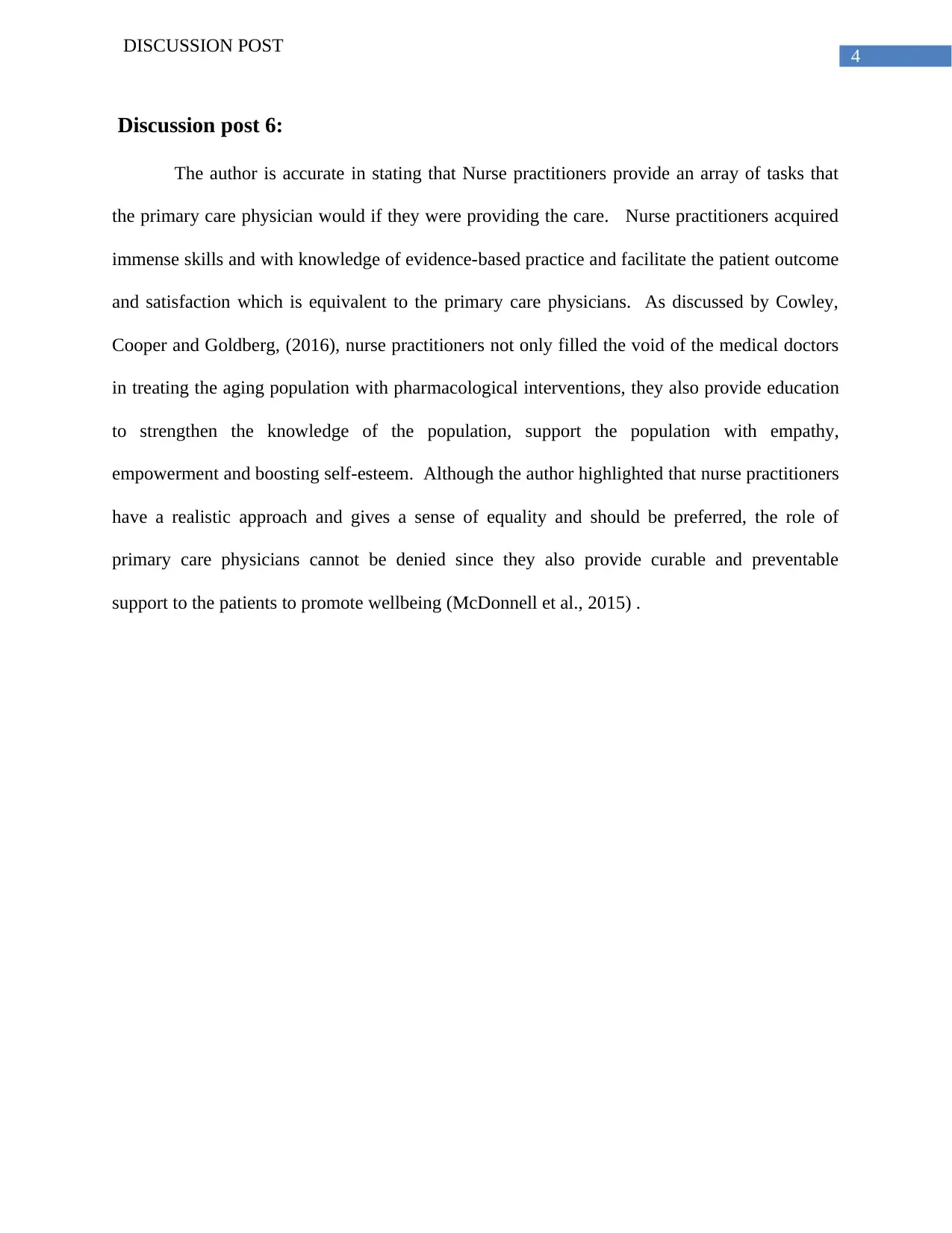
4
DISCUSSION POST
Discussion post 6:
The author is accurate in stating that Nurse practitioners provide an array of tasks that
the primary care physician would if they were providing the care. Nurse practitioners acquired
immense skills and with knowledge of evidence-based practice and facilitate the patient outcome
and satisfaction which is equivalent to the primary care physicians. As discussed by Cowley,
Cooper and Goldberg, (2016), nurse practitioners not only filled the void of the medical doctors
in treating the aging population with pharmacological interventions, they also provide education
to strengthen the knowledge of the population, support the population with empathy,
empowerment and boosting self-esteem. Although the author highlighted that nurse practitioners
have a realistic approach and gives a sense of equality and should be preferred, the role of
primary care physicians cannot be denied since they also provide curable and preventable
support to the patients to promote wellbeing (McDonnell et al., 2015) .
DISCUSSION POST
Discussion post 6:
The author is accurate in stating that Nurse practitioners provide an array of tasks that
the primary care physician would if they were providing the care. Nurse practitioners acquired
immense skills and with knowledge of evidence-based practice and facilitate the patient outcome
and satisfaction which is equivalent to the primary care physicians. As discussed by Cowley,
Cooper and Goldberg, (2016), nurse practitioners not only filled the void of the medical doctors
in treating the aging population with pharmacological interventions, they also provide education
to strengthen the knowledge of the population, support the population with empathy,
empowerment and boosting self-esteem. Although the author highlighted that nurse practitioners
have a realistic approach and gives a sense of equality and should be preferred, the role of
primary care physicians cannot be denied since they also provide curable and preventable
support to the patients to promote wellbeing (McDonnell et al., 2015) .
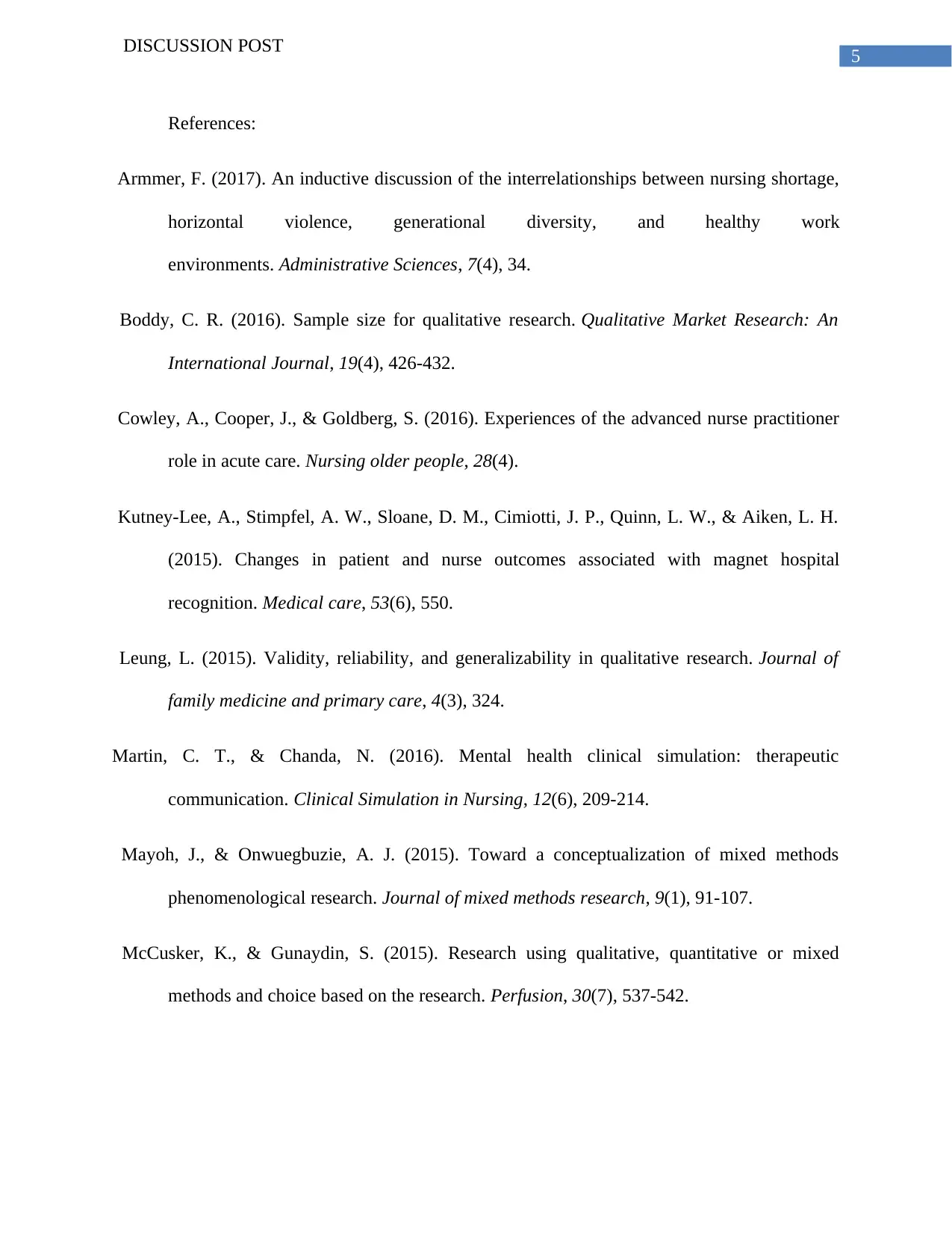
5
DISCUSSION POST
References:
Armmer, F. (2017). An inductive discussion of the interrelationships between nursing shortage,
horizontal violence, generational diversity, and healthy work
environments. Administrative Sciences, 7(4), 34.
Boddy, C. R. (2016). Sample size for qualitative research. Qualitative Market Research: An
International Journal, 19(4), 426-432.
Cowley, A., Cooper, J., & Goldberg, S. (2016). Experiences of the advanced nurse practitioner
role in acute care. Nursing older people, 28(4).
Kutney-Lee, A., Stimpfel, A. W., Sloane, D. M., Cimiotti, J. P., Quinn, L. W., & Aiken, L. H.
(2015). Changes in patient and nurse outcomes associated with magnet hospital
recognition. Medical care, 53(6), 550.
Leung, L. (2015). Validity, reliability, and generalizability in qualitative research. Journal of
family medicine and primary care, 4(3), 324.
Martin, C. T., & Chanda, N. (2016). Mental health clinical simulation: therapeutic
communication. Clinical Simulation in Nursing, 12(6), 209-214.
Mayoh, J., & Onwuegbuzie, A. J. (2015). Toward a conceptualization of mixed methods
phenomenological research. Journal of mixed methods research, 9(1), 91-107.
McCusker, K., & Gunaydin, S. (2015). Research using qualitative, quantitative or mixed
methods and choice based on the research. Perfusion, 30(7), 537-542.
DISCUSSION POST
References:
Armmer, F. (2017). An inductive discussion of the interrelationships between nursing shortage,
horizontal violence, generational diversity, and healthy work
environments. Administrative Sciences, 7(4), 34.
Boddy, C. R. (2016). Sample size for qualitative research. Qualitative Market Research: An
International Journal, 19(4), 426-432.
Cowley, A., Cooper, J., & Goldberg, S. (2016). Experiences of the advanced nurse practitioner
role in acute care. Nursing older people, 28(4).
Kutney-Lee, A., Stimpfel, A. W., Sloane, D. M., Cimiotti, J. P., Quinn, L. W., & Aiken, L. H.
(2015). Changes in patient and nurse outcomes associated with magnet hospital
recognition. Medical care, 53(6), 550.
Leung, L. (2015). Validity, reliability, and generalizability in qualitative research. Journal of
family medicine and primary care, 4(3), 324.
Martin, C. T., & Chanda, N. (2016). Mental health clinical simulation: therapeutic
communication. Clinical Simulation in Nursing, 12(6), 209-214.
Mayoh, J., & Onwuegbuzie, A. J. (2015). Toward a conceptualization of mixed methods
phenomenological research. Journal of mixed methods research, 9(1), 91-107.
McCusker, K., & Gunaydin, S. (2015). Research using qualitative, quantitative or mixed
methods and choice based on the research. Perfusion, 30(7), 537-542.
⊘ This is a preview!⊘
Do you want full access?
Subscribe today to unlock all pages.

Trusted by 1+ million students worldwide
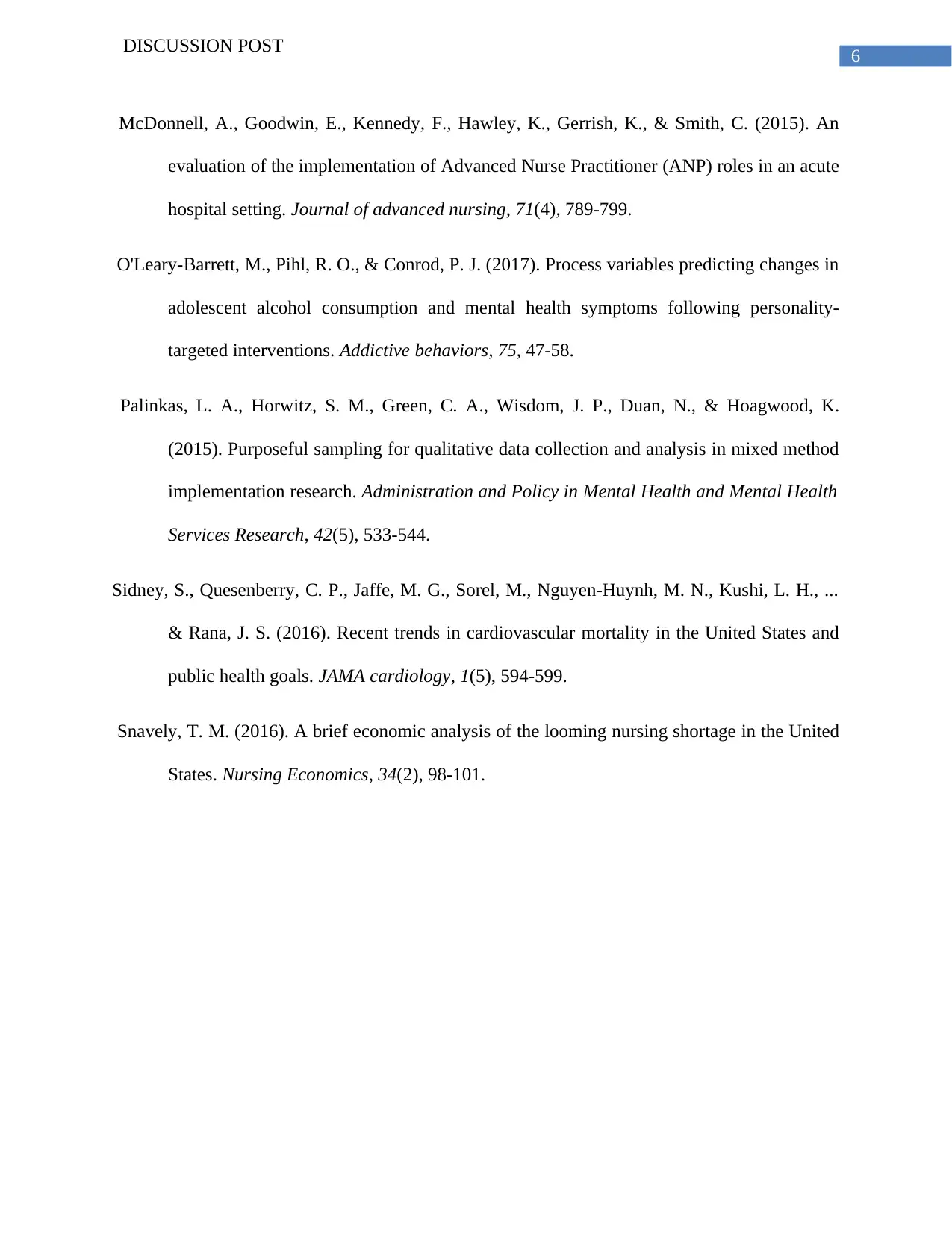
6
DISCUSSION POST
McDonnell, A., Goodwin, E., Kennedy, F., Hawley, K., Gerrish, K., & Smith, C. (2015). An
evaluation of the implementation of Advanced Nurse Practitioner (ANP) roles in an acute
hospital setting. Journal of advanced nursing, 71(4), 789-799.
O'Leary-Barrett, M., Pihl, R. O., & Conrod, P. J. (2017). Process variables predicting changes in
adolescent alcohol consumption and mental health symptoms following personality-
targeted interventions. Addictive behaviors, 75, 47-58.
Palinkas, L. A., Horwitz, S. M., Green, C. A., Wisdom, J. P., Duan, N., & Hoagwood, K.
(2015). Purposeful sampling for qualitative data collection and analysis in mixed method
implementation research. Administration and Policy in Mental Health and Mental Health
Services Research, 42(5), 533-544.
Sidney, S., Quesenberry, C. P., Jaffe, M. G., Sorel, M., Nguyen-Huynh, M. N., Kushi, L. H., ...
& Rana, J. S. (2016). Recent trends in cardiovascular mortality in the United States and
public health goals. JAMA cardiology, 1(5), 594-599.
Snavely, T. M. (2016). A brief economic analysis of the looming nursing shortage in the United
States. Nursing Economics, 34(2), 98-101.
DISCUSSION POST
McDonnell, A., Goodwin, E., Kennedy, F., Hawley, K., Gerrish, K., & Smith, C. (2015). An
evaluation of the implementation of Advanced Nurse Practitioner (ANP) roles in an acute
hospital setting. Journal of advanced nursing, 71(4), 789-799.
O'Leary-Barrett, M., Pihl, R. O., & Conrod, P. J. (2017). Process variables predicting changes in
adolescent alcohol consumption and mental health symptoms following personality-
targeted interventions. Addictive behaviors, 75, 47-58.
Palinkas, L. A., Horwitz, S. M., Green, C. A., Wisdom, J. P., Duan, N., & Hoagwood, K.
(2015). Purposeful sampling for qualitative data collection and analysis in mixed method
implementation research. Administration and Policy in Mental Health and Mental Health
Services Research, 42(5), 533-544.
Sidney, S., Quesenberry, C. P., Jaffe, M. G., Sorel, M., Nguyen-Huynh, M. N., Kushi, L. H., ...
& Rana, J. S. (2016). Recent trends in cardiovascular mortality in the United States and
public health goals. JAMA cardiology, 1(5), 594-599.
Snavely, T. M. (2016). A brief economic analysis of the looming nursing shortage in the United
States. Nursing Economics, 34(2), 98-101.
1 out of 7
Related Documents
Your All-in-One AI-Powered Toolkit for Academic Success.
+13062052269
info@desklib.com
Available 24*7 on WhatsApp / Email
![[object Object]](/_next/static/media/star-bottom.7253800d.svg)
Unlock your academic potential
Copyright © 2020–2025 A2Z Services. All Rights Reserved. Developed and managed by ZUCOL.





